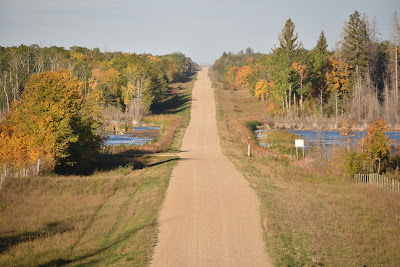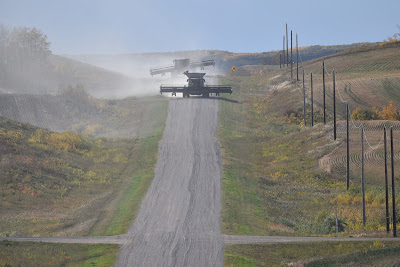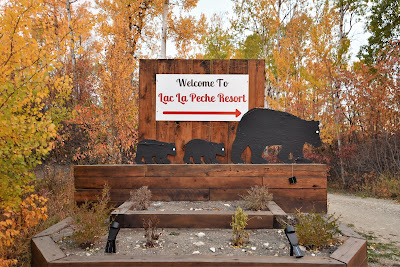Prairie Winds and Fall Colours : Wingard Ferry to Lac la Peche
Although there were a few small showers last night, to our surprise, when we opened the tent this morning the outside world was relatively dry, and the sky was clear. The moon was still hanging big and bright in the soft blue and pink sky, facing the sun, which was just starting to peek over the opposite horizon. Already we could hear the large flocks of Snow and Canada Geese flying by overhead in the cool, still morning.
We made breakfast, packed up, and reluctantly left our cozy, treed spot behind. As we made our way through the tall grass and small shrubs to the road we were very grateful for the lack of dew, which could easily have soaked our legs from the knees down. Before us the undulating road stretched out in a long straight line to the horizon, heading due west. Uninterrupted. For the next 150 km.
It was another stunningly gorgeous autumn morning. Rolling hills of light brown, gold, and emerald green stretched out around us, interspersed with stands of brilliant yellow, orange, and dark green trees. Small pothole lakes were scattered throughout, their surfaces a stronger and deeper blue than the sky above, and their edges bordered in green and brown cattails. Large beaver lodges dominated many of the ponds, and we spotted a beaver placidly swimming across one of them.
Hundreds of waterfowl were also resting in each and every one of these water-bodies, but many skittishly took flight at our approach. Wood Ducks, Green Winged Teals, Buffleheads, American Wigeons, Northern Pintails, and Northern Shovelers were among the most prevalent species we saw. Greater Yellowlegs were also foraging in many of the shallower ponds, as well as grebes which were too far away for accurate identification.
As we made our way through the wide open landscape, farmers were out in the fields on both sides of us, collecting hay bales and harvesting their crops. Today these operations created enormous clouds of dark brown soil that traveled huge distances across the fields, looking to us like the smoke from forest fires. I'm not sure if it was a result of these harvesting activities or not, but just like in Western movies there were giant tumbleweeds blowing across the fields and crossing the road in front of us!
As we approached highway 40 we were passed by a lot of traffic - large farm machinery, trucks hauling gravel back and forth, pickup trucks hauling huge loads of hay, and quite a few cars. Many of the drivers were very considerate, passing us with a smile and a friendly wave, but no matter how far they pulled over or how much they slowed down for us, each vehicle covered us in huge, choking clouds of fine, thick, grey dust. A high point was a lady who stopped to chat both on her way into town and on her way back, her cheerful questions and good wishes perking us up as we struggled along.
After crossing the paved highway we found ourselves in the community of Marcelin. One of the Riverside Heritage Tour signs indicated that the town, which was founded by Antoine Marcelin, had originally been located one half mile east of its current position. When the Canadian Pacific Railway put down tracks in 1913 that bypassed the village, it was quickly relocated one half mile west. In the age of cars, it is difficult to imagine how going to the trouble of moving a town such a short distance just to line up with the railway line would be worthwhile. However, that was the power and importance of the train lines to the development of this nation.
The community of Marcelin was quite large, and we stopped at the Co-op for a few resupplies and a snack, which we enjoyed while sitting in the grassy park beside the baseball diamond. It felt wonderful to be out of the fierce and relentless wind for a few minutes, and to simply relax in the warm fall sunshine.
On our way out of town we passed by the St. Joseph Roman Catholic Church. The first church was erected in 1904 at the original town site, and the current structure was built in 1922 to house a growing congregation in the 'new' town site. The towering steeple, which was visible for miles around the town in all directions, and the colourful stained glass windows reminded us of the churches in Europe.
As we headed back out into the howling wind, we had hoped that traffic might be a little less busy on this side of the highway. That turned out not to be the case. About once every thirty seconds we were passed by a vehicle that engulfed us in dust, and many of them were so large we had to divert down the steep sides of the ditch to get out of their way. The most impressive of these occurrences was a convoy of three truly enormous combines that came down the road towards us, each one being nearly twice as wide as the gravel road! Yet, despite the size of the farming machinery that was on the move, local drivers in trucks would often race around them in the ditches - much to our terror!
By mid afternoon our trek was a total body workout - walking into the strong prairie winds, pulling the carts through the ever deepening sand and gravel of the roads and constantly trekking uphill.
As we steadily climbed and climbed and climbed on the soft sandy roads, battling against the wind, a few of the drivers stopped to chat. A lovely couple in a pickup truck asked us if we were walking the trail, told us about their cabin farther down the road, and wished us 'Happy Travels!' One of the farmers who must have passed us a dozen times as he transported bales of hay from a field ahead of us to a point somewhere behind, offered to give us a ride up one of the tallest, steepest hills. Although we were sorely tempted, with so much gear we thanked him and politely declined.
As the afternoon wore on, nature put on a truly spectacular show. We found ourselves looking out over a stunning valley, at the bottom of which the ruffled blue waters of Paddling Lake reflected the sky above. On our side of the lake, old barns and outbuildings dotted fields that were glowing golden in the afternoon sun. Beyond the ruffled waters hills covered in a colourful patchwork blanket of warm oranges, yellows and dark greens rose up to meet a bank of heavy storm clouds. Streaks of light filtered through the dark blue and grey clouds, and shafts of white rain fell diagonally across the hills, blown sideways by the wind.
We continued climbing, our level of exhaustion and our desperation to escape the roaring wind and dust steadily growing. As evening approached we passed a large quarry, and then found ourselves back in a more treed landscape as the temperatures began to plummet towards the freezing mark. Sadly, because the wind was blowing straight down the road at us, the trees provided little shelter. In addition, as we passed farms and began to see cows grazing in among the trees, we found ourselves between two lines of fences, posted with 'No Trespassing' and 'Trespassers will be Prosecuted' signs.
When we saw the turn-off for La Peche Lac, we stopped and called the Lac La Peche Resort to see if there were any cabins available for the night. As we spoke on the phone with the extremely helpful and friendly owner, a bull moose with a beautiful set of antlers walked out onto the road and stopped. We watched in awe, only to realize it was standing on the down slope of a steep hill, and a truck fully loaded with a mountain of hay bales was fast approaching the crest of the hill from the other direction. Luckily the moose decided to amble slowly off into the bushes, thus averting a messy disaster. A few moments later a second moose appeared a little farther down the road, crossing back in the other direction!
Since there was only a cabin available we were easily seduced by the promise of shelter from the wind and frost, a warm coin-operated shower to remove the day's accumulated dirt, and a bed in which to rest our sore and over-exerted muscles. The owner even escorted us down the road on his golf cart, indicating that he remembered Mel and Malo, whom he thought passed through last summer!
Our cabin for the night is tucked into a treed spot on the shores of Lac La Peche, with a beautiful view out over the water. Bright yellow foliage surrounds the deck and fire pit, and it is full of Black-capped Chickadees, Yellow-rumped Warblers, Dark-eyed Juncos, Blue Jays, and American Robins.
After a long day on the road, we are sitting down to figure out the next stage of our journey, having determined that it is not responsible to continue hiking west into Alberta as that province's health care system has become overwhelmed by the fourth wave of the pandemic. As we look out at the nearly full moon shining brightly above the far shore of the lake, and look out at the glowing moon trail stretching out before us, we wonder where our own path will lead us next?
See you on the trail!
Remember to follow our entire adventure here : www.comewalkwithus.online

























































Comments
Post a Comment